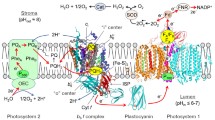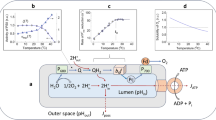Abstract
A modified ‘cold chase’ technique was used to study tight [14C]ADP and [14C]ATP binding to noncatalytic sites of chloroplast ATP synthase (CF0F1). The binding was very low in the dark and sharply increased with light intensity. Dissociation of labeled nucleotides incorporated into noncatalytic sites of CF0F1 or CF1 reconstituted with EDTA-treated thylakoid membranes was also found to be light-dependent. Time dependence of nucleotide dissociation is described by the first order equation with a k d of about 5 min−1. The exposure of thylakoid membranes to 0.7–24.8 μM nucleotides leads to filling of up to two noncatalytic sites of CF0F1. The sites differ in their specificity: one preferentially binds ADP, whereas the other – ATP. A much higher ATP/ADP ratio of nucleotides bound at noncatalytic sites of isolated CF1 dramatically decreases upon its reconstitution with EDTA-treated thylakoid membranes. It is suggested that the decrease is caused by conformational changes in one of the α subunits induced by its interaction with the δ subunit and/or subunit I–II when CF1 becomes bound to a thylakoid membrane.
Similar content being viewed by others
Abbreviations
- CF1 :
-
chloroplast coupling factor 1
- CF0F1 :
-
chloroplast ATP synthase
- DTT:
-
dithiothreitol
- PMS:
-
phenazine methosulfate
References
Abrahams JP, Leslie AG, Lutter R, Walker JE, (1994) Structure at 2.8 Å resolution of F1-ATPase from bovine heart mitochondriaNature 381: 623–625
Arnon DJ, (1949) Copper enzymes in isolated chloroplasts. Polyphenyloxidase in Beta vulgarisPlant Physiol 24: 1–5
Bandyopadhyay S, Ren H, Wang GS, Allison WS, (2002) The (alpha F(357)C)(3)(beta R(372)C)(3)gamma subcomplex of the F(1)-ATPase from the thermophilic Bacillus PS3 has altered ATPase activity after cross-linking alpha and beta subunits at noncatalytic site interfacesBiochemistry 41: 3226–3234
Binder A, Jagendorf AT, Ngo E, (1978) Isolation and composition of the subunits of spinach chloroplast coupling factor proteinJ Biol Chem 253: 3094–3100
Boersch M, Diez M, Zimmermann B, Reuter R, Graeber P, (2002) Stepwise rotation of the gamma-subunit of EF0F1-ATPsynthase observed by intramolecular single-molecule fluorescence resonance energy transferFEBS Lett 527:147–152
Boyer PD, (1997) The ATP synthase – a splendid molecular machineAnn Rev Biochem 66: 717–749
Bradford MM, (1976) A rapid and sensitive method for the quantitation of microgram quantities of protein utilizing the principle of protein–dye bindingAnal Biochem 72: 248–254
Cross RL, Nalin CM, (1982) Adenine nucleotide binding sites on beef heart F1-ATPase. Evidence for three exchangeable sites that are distinct from three noncatalytic sitesJ Biol Chem 257: 2874–2881
Czarnecki JJ, Abbott MS, Selman BR, (1983) Localization of the tight ADP-binding site on the membrane-bound chloroplast coupling factor oneEur J Biochem 136: 19–24
Du Z, Boyer PD, (1990) On the mechanism of sulfite activation of chloroplast thylakoid ATPase and the relation of ADP tightly bound at catalytic site to the binding change mechanismBiochemistry 29: 402–407
Feldman RI, Boyer PD, (1985) The role of tightly bound ADP on chloroplast ATPaseJ Biol Chem 260: 13,088–13,094
Groth G, Junge W, (1993) Proton slip of the chloroplast ATPase: its nucleotide dependence, energetic threshold, and relation to an alternating site mechanism of catalysisBiochemistry 32: 8103–8111
Guerrero KJ, Ehler LL, Boyer PD, (1990) Guanosine and formicin triphosphates bind at non-catalytic nucleotide binding sites of CF1 ATPase and inhibit ATP hydrolysisFEBS Lett 270: 187–190
Harris DA, Slater EC, (1975) Tightly bound nucleotides of the energy-transducing ATPase of chloroplasts and their role in photophosphorylationBiochim Biophys Acta 387: 335–348
Hyndman DJ, Milgrom YM, Bramhall EA, Cross RL, (1994) Nucleotide binding sites on E. coli F1-ATPase. Specificity of noncatalytic sites and inhibition at catalytic sites by MgADPJ Biol Chem 269: 28,871–28,877
Jault J-M, Allison WS, (1993) Slow binding of ATP to noncatalytic nucleotide binding sites which accelerates catalysis is responsible for apparent negative cooperativity exhibited by the bovine mitochondrial F1-ATPaseJ Biol Chem 268: 1558–1566
Junesh U, Graeber P, (1987) Influence of the redox state and the activation of the chloroplast ATP synthase on proton-transport-coupled ATP synthesis/hydrolysisBiochim Biophys Acta 893: 275–288
Karu AE, Moudrianakis EN, (1969) Fractionation and comparative studies of enzymes in aqueous extracts of spinach chloroplastsArch Biochem Biophys 129: 655–671
Kironde FA, Cross RL, (1987) Adenine nucleotide binding sites on beef heart F1-ATPase. Asymmetry and subunit locationsJ Biol Chem 262: 3488–3495
Larson EM, Jagendorf AT, (1989) Sulfite stimulation of chloroplast coupling factor ATPaseBiochim Biophys Acta 973: 67–77
Larson EM, Umbach A, Jagendorf AT, (1989) Sulfite stimulated release of [3H]ADP bound to chloroplast thylakoid ATPaseBiochim Biophys Acta 973: 78–85
Loesel RM, Wise JG, Vogel PD., (1997) Asymmetry of catalytic but not of non-catalytic siteson E.C.F1-ATPase in solutions as observed using electron spin resonance spectroscopyBiochemistry 36: 1188–1193
Lohse D, Strotmann H, (1989) Reactions related with ΔμH+-dependent activation of the chloroplast H+-ATPaseBiochim Biophys Acta 976: 94–101
Lohse D, Thelen R, Strotmann H, (1989) Activity equilibria of the thiol-modulated chloroplast H+-ATPase as a function of the proton gradient in the absence and presence of ADP and arsenateBiochim Biophys Acta 976: 85–93
Malyan AN, Vitseva OI, (1983) Presteady-state kinetics of the hydrolysis of ATP by chloroplast CF1ATPaseBiochemistry (Moscow) 48: 618–623
Malyan AN, Vitseva OI, (1990) Kinetic analysis of ADP- and Mg2+-dependent inactivation of CF1-ATPasePhotosynthetica 24: 613–622
Malyan AN, Allison WS, (2002) Properties of noncatalytic sites of thioredoxin-activated chloroplast coupling factor 1Biochim Biophys Acta 1554: 153–158
Matsui T, Muneyuki E, Honda M, Allison WS, Dou C, Yoshida M, (1997) Catalytic activity of the α3β3γ complex of F1-ATPase without noncatalytic nucleotide binding siteJ Biol Chem 272: 8215–8221
McCarty RE, Fuhrman JS, Tsuchiya Y, (1971) Effects of adenine nucleotides on hydrogen-ion transport in chloroplastsProc Nat Acad Sci 68: 2522–2526
Milgrom YM, Ehler LL, Boyer PD, (1990) ATP binding at noncatalytic sites of soluble chloroplast F1-ATPase is required for expression of the enzyme activityJ Biol Chem 265: 18,725–18,728
Milgrom YM, Ehler LL, Boyer PD, (1991) The characteristics and effect on catalysis of nucleotide binding to noncatalytic sites of chloroplast F1-ATPaseJ Biol Chem 266: 11,551–11,558
Milgrom YM, Cross RL, (1993) Nucleotide binding sites on beef heart mitochondrial F1-ATPase. Cooperative interactions between sites and specificity of noncatalytic sitesJ Biol Chem 268: 23,179–23,185
Murataliev MB, Boyer PD, (1992) The mechanism of stimulation of MgATPase activity of chloroplast F1-ATPase by non-catalytic adenine-nucleotide bindingEur J Biochem 209: 681–687
Nalin CM, McCarty RE, (1984) Role of a disulfide bond in the gamma subunit in activation of the ATPase of chloroplast coupling factor 1J Biol Chem 259: 7275–7280
Nelson N, (1976) Structure and function of chloroplast ATPaseBiochim Biophys Acta 456: 314–338
Ogilvie I, Aggeler R, Capaldi RA, (1997) Cross-linking of the delta subunit to one of the three alpha subunits has no effect on functioning, as expected if delta is a part of the stator that links the F1 and F0 parts of the E. coli ATP synthaseJ Biol Chem 272: 16,652–16,656
Possmayer FE, Hartog AF, Berden JA, Graeber P, (2001) Covalent modification of the non-catalytic sites of he H+-ATPase from chloroplasts with 2-azido-[α-32P]ATP and its effect on ATP synthesis and ATP hydrolysisBiochim Biophys Acta 1510:378–400
Rodgers AJW, Capaldi RA, (1998) The second stalk composed of the b- and delta subunits connects F0 to F1 via an alpha-subunit in the E. coli ATP synthaseJ Biol Chem 273: 29,406–29,410
Semenova GA, Agafonov AV, Opanasenko VK, (1996) Light induced reversible local fusions of thylakoid membranes in the presence dubicain and tetracainBiochim Biophys Acta 1285: 29–37
Shigalova T, Lehmann U, Krevet M, Strotmann H, (1985) Transient stimulation of light-triggered ATP hydrolysis by preillumination of chloroplasts in the presence of ATPBiochim Biophys Acta 809: 57–65
Strotmann H, Hesse H, Edelmann K, (1973) Quantitative determination of coupling factor CF1 of chloroplastsBiochim Bophys Acta 314: 202–210
Tucker WC, Schwarz A, Levine T, Du Z, Gromet-Elhanan Z, Richter M, Haran G, (2004) Observation of calcium-dependent unidirectional rotational motion in recombinant photosynthetic F1-ATPase moleculesJ Biol Chem 279: 47,415–47,418
Vasilyeva EA, Minkov B, Fitin AF, Vinogradov AD, (1982) Kinetic mechanism of mitochondrial adenosine triphosphatase. ADP specific inhibition as revealed by the steady-state kineticsBiochem J 202: 9–14
Weber J, Wilke-Mounts S, Grell E, Senior AE, (1994) Tryptophan fluorescence provides a direct probe of nucleotide binding in the noncatalytic sites of Escherichia coli F1-ATPaseJ Biol Chem 269: 11,261–11,268
Weber J, Senior AE, (1997) Catalytic mechanism of F1-ATPaseBiochem Biophys Acta 1319: 19–58
Weber J, Senior AE, (2003) ATP synthesis driven by proton transport in F1F0-ATP synthaseFEBS Lett 545: 61–70
Xue Z, Miller CG, Zhou J-M, Boyer PD, (1987) Catalytic and noncatalytic nucleotide binding sites of chloroplast F1 ATPaseFEBS Lett 223: 391–394
Xue Z, Boyer PD, (1989) Modulation of the GTPase activity of the chloroplast F1-ATPase by ATP binding at noncatalytic sitesEur J Biochem 179: 677–681
Zhou JM, Xue Z, Du Z, Melese T, Boyer PD, (1988) Relationship of tightly bound ADP and ATP to control and catalysis by chloroplast ATP synthaseBiochemistry 27: 5129–5135
Zhou Y, Duncan TM, Bulygin VV, Hutcheon ML, Cross RL, (1996) ATP hydrolysis by membrane-bound E. coli FoF1 causes rotation of the gamma subunit relative to the beta subunitsBiocim Biophys Acta 1275: 96–100
Acknowledgements
The author thanks Prof. William S. Allison for valuable comments and critical reading of the manuscript and E.V. Serebrova for assistance in manuscript preparation. This study was supported in part by a grant from the Russian Foundation for Basic Research (No. 03–04-48020).
Author information
Authors and Affiliations
Corresponding author
Rights and permissions
About this article
Cite this article
Malyan, A.N. ADP and ATP binding to noncatalytic sites of thiol-modulated chloroplast ATP synthase. Photosynth Res 88, 9–18 (2006). https://doi.org/10.1007/s11120-005-9025-9
Received:
Accepted:
Published:
Issue Date:
DOI: https://doi.org/10.1007/s11120-005-9025-9




